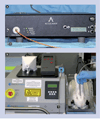Transcranial near-infrared laser therapy applied to promote clinical recovery in acute and chronic neurodegenerative diseases
- PMID: 22145842
- PMCID: PMC3270070
- DOI: 10.1586/erd.11.64
Transcranial near-infrared laser therapy applied to promote clinical recovery in acute and chronic neurodegenerative diseases
Abstract
One of the most promising methods to treat neurodegeneration is noninvasive transcranial near-infrared laser therapy (NILT), which appears to promote acute neuroprotection by stimulating mitochondrial function, thereby increasing cellular energy production. NILT may also promote chronic neuronal function restoration via trophic factor-mediated plasticity changes or possibly neurogenesis. Clearly, NILT is a treatment that confers neuroprotection or neurorestoration using pleiotropic mechanisms. The most advanced application of NILT is for acute ischemic stroke based upon extensive preclinical and clinical studies. In laboratory settings, NILT is also being developed to treat traumatic brain injury, Alzheimer's disease and Parkinson's disease. There is some intriguing data in the literature that suggests that NILT may be a method to promote clinical improvement in neurodegenerative diseases where there is a common mechanistic component, mitochondrial dysfunction and energy impairment. This article will analyze and review data supporting the continued development of NILT to treat neurodegenerative diseases.
Conflict of interest statement
The author has no other relevant affiliations or financial involvement with any organization or entity with a financial interest in or financial conflict with the subject matter or materials discussed in the manuscript apart from those disclosed.
No writing assistance was utilized in the production of this manuscript.
PA Lapchak is Director of Translational Research at Cedars-Sinai Medical Center and is on the Scientific Advisory Boards of Photothera Inc. He has no financial interest in Photothera Inc. Photothera Inc. did not pay the author to contribute this article to the scientific literature and had no editorial influence on the scientific content or opinions in this article.
Figures




Similar articles
-
Transcranial Near-Infrared Laser Transmission (NILT) Profiles (800 nm): Systematic Comparison in Four Common Research Species.PLoS One. 2015 Jun 3;10(6):e0127580. doi: 10.1371/journal.pone.0127580. eCollection 2015. PLoS One. 2015. PMID: 26039354 Free PMC article.
-
Taking a light approach to treating acute ischemic stroke patients: transcranial near-infrared laser therapy translational science.Ann Med. 2010 Dec;42(8):576-86. doi: 10.3109/07853890.2010.532811. Epub 2010 Nov 1. Ann Med. 2010. PMID: 21039081 Free PMC article. Review.
-
Transcranial near infrared laser treatment (NILT) increases cortical adenosine-5'-triphosphate (ATP) content following embolic strokes in rabbits.Brain Res. 2010 Jan 8;1306:100-5. doi: 10.1016/j.brainres.2009.10.022. Epub 2009 Oct 23. Brain Res. 2010. PMID: 19837048
-
Transcranial Near-Infrared Laser Therapy for Stroke: How to Recover from Futility in the NEST-3 Clinical Trial.Acta Neurochir Suppl. 2016;121:7-12. doi: 10.1007/978-3-319-18497-5_2. Acta Neurochir Suppl. 2016. PMID: 26463915
-
Transcranial Near-infrared Laser Therapy in Improving Cognitive Recovery of Function Following Traumatic Brain Injury.Curr Neuropharmacol. 2018;16(9):1320-1326. doi: 10.2174/1570159X16666180321100439. Curr Neuropharmacol. 2018. PMID: 29564977 Free PMC article. Review.
Cited by
-
Near-infrared photonic energy penetration: can infrared phototherapy effectively reach the human brain?Neuropsychiatr Dis Treat. 2015 Aug 21;11:2191-208. doi: 10.2147/NDT.S78182. eCollection 2015. Neuropsychiatr Dis Treat. 2015. PMID: 26346298 Free PMC article. Review.
-
Method for the assessment of effects of a range of wavelengths and intensities of red/near-infrared light therapy on oxidative stress in vitro.J Vis Exp. 2015 Mar 21;(97):52221. doi: 10.3791/52221. J Vis Exp. 2015. PMID: 25867757 Free PMC article.
-
Transcranial Near-Infrared Laser Transmission (NILT) Profiles (800 nm): Systematic Comparison in Four Common Research Species.PLoS One. 2015 Jun 3;10(6):e0127580. doi: 10.1371/journal.pone.0127580. eCollection 2015. PLoS One. 2015. PMID: 26039354 Free PMC article.
-
Transcranial photobiomodulation (laser) therapy for cognitive impairment: A review of molecular mechanisms and potential application to canine cognitive dysfunction (CCD).Open Vet J. 2022 Mar-Apr;12(2):256-263. doi: 10.5455/OVJ.2022.v12.i2.14. Epub 2022 Apr 17. Open Vet J. 2022. PMID: 35603072 Free PMC article. Review.
-
Phototherapy of Alzheimer's Disease: Photostimulation of Brain Lymphatics during Sleep: A Systematic Review.Int J Mol Sci. 2023 Jun 30;24(13):10946. doi: 10.3390/ijms241310946. Int J Mol Sci. 2023. PMID: 37446135 Free PMC article.
References
-
- Anders JJ, Borke RC, Woolery SK, Van de Merwe WP. Low power laser irradiation alters the rate of regeneration of the rat facial nerve. Lasers Surg. Med. 1993;13(1):72–82. - PubMed
-
- Castro-e-Silva O, Jr, Zucoloto S, Marcassa LG, et al. Spectral response for laser enhancement in hepatic regeneration for hepatectomized rats. Lasers Surg. Med. 2003;32(1):50–53. - PubMed
-
- Mochizuki-Oda N, Kataoka Y, Cui Y, Yamada H, Heya M, Awazu K. Effects of near-infra-red laser irradiation on adenosine triphosphate and adenosine diphosphate contents of rat brain tissue. Neurosci. Lett. 2002;323(3):207–210. - PubMed
-
- Desmet KD, Paz DA, Corry JJ, et al. Clinical and experimental applications of NIR-LED photobiomodulation. Photomed. Laser Surg. 2006;24(2):121–128. - PubMed
Website
Patent
-
- Streeter, et al. US2011/0144723 A1 2011
Publication types
MeSH terms
Grants and funding
LinkOut - more resources
Full Text Sources
Other Literature Sources
Medical
